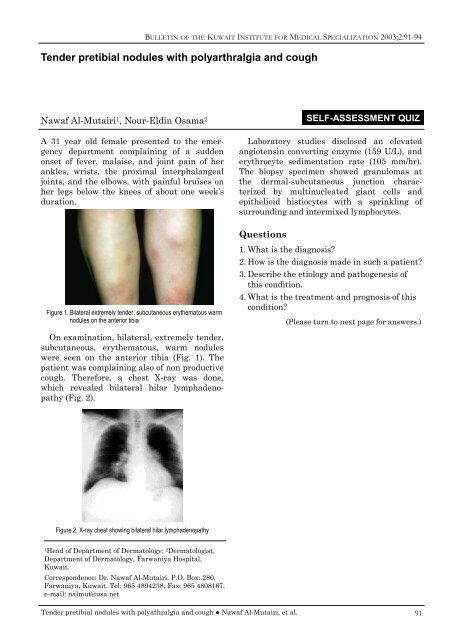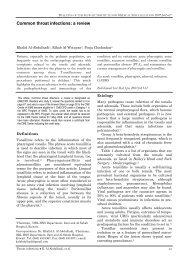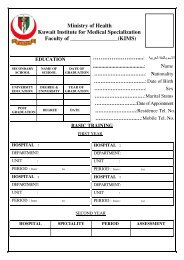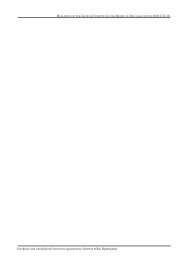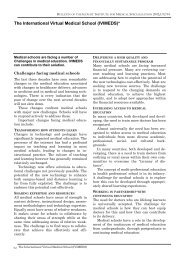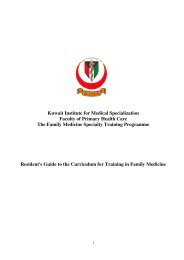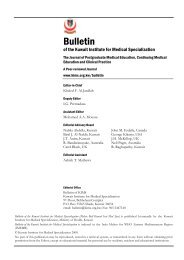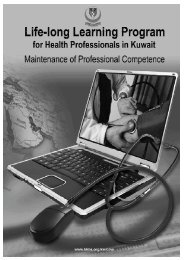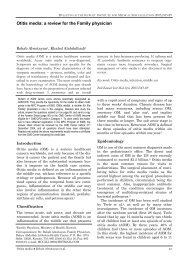Tender pretibial nodules with polyarthralgia and cough
Tender pretibial nodules with polyarthralgia and cough
Tender pretibial nodules with polyarthralgia and cough
You also want an ePaper? Increase the reach of your titles
YUMPU automatically turns print PDFs into web optimized ePapers that Google loves.
BULLETIN OF THE KUWAIT INSTITUTE FOR MEDICAL SPECIALIZATION 2003;2:91-94<br />
<strong>Tender</strong> <strong>pretibial</strong> <strong>nodules</strong> <strong>with</strong> <strong>polyarthralgia</strong> <strong>and</strong> <strong>cough</strong><br />
Nawaf Al-Mutairi 1 , Nour-Eldin Osama 2<br />
A 31 year old female presented to the emergency<br />
department complaining of a sudden<br />
onset of fever, malaise, <strong>and</strong> joint pain of her<br />
ankles, wrists, the proximal interphalangeal<br />
joints, <strong>and</strong> the elbows, <strong>with</strong> painful bruises on<br />
her legs below the knees of about one week’s<br />
duration.<br />
Figure 1. Bilateral extremely tender, subcutaneous erythematous warm<br />
<strong>nodules</strong> on the anterior tibia<br />
On examination, bilateral, extremely tender,<br />
subcutaneous, erythematous, warm <strong>nodules</strong><br />
were seen on the anterior tibia (Fig. 1). The<br />
patient was complaining also of non productive<br />
<strong>cough</strong>. Therefore, a chest X-ray was done,<br />
which revealed bilateral hilar lymphadenopathy<br />
(Fig. 2).<br />
Figure 2. X-ray chest showing bilateral hilar lymphadenopathy<br />
1Head of Department of Dermatology; 2Dermatologist,<br />
Department of Dermatology, Farwaniya Hospital,<br />
Kuwait.<br />
Correspondence: Dr. Nawaf Al-Mutairi, P.O. Box: 280,<br />
Farwaniya, Kuwait. Tel: 965 4894238; Fax: 965 4808167.<br />
e-mail: nalmut@usa.net<br />
<strong>Tender</strong> <strong>pretibial</strong> <strong>nodules</strong> <strong>with</strong> polyathralgia <strong>and</strong> <strong>cough</strong> ● Nawaf Al-Mutairi, et al.<br />
SELF-ASSESSMENT QUIZ<br />
Laboratory studies disclosed an elevated<br />
angiotensin converting enzyme (159 U/L), <strong>and</strong><br />
erythrocyte sedimentation rate (105 mm/hr).<br />
The biopsy specimen showed granulomas at<br />
the dermal-subcutaneous junction characterized<br />
by multinucleated giant cells <strong>and</strong><br />
epithelioid histiocytes <strong>with</strong> a sprinkling of<br />
surrounding <strong>and</strong> intermixed lymphocytes.<br />
Questions<br />
1. What is the diagnosis?<br />
2. How is the diagnosis made in such a patient?<br />
3. Describe the etiology <strong>and</strong> pathogenesis of<br />
this condition.<br />
4. What is the treatment <strong>and</strong> prognosis of this<br />
condition?<br />
(Please turn to next page for answers.)<br />
91
BULLETIN OF THE KUWAIT INSTITUTE FOR MEDICAL SPECIALIZATION 2003;2:91-94<br />
Answers<br />
1. What is the diagnosis?<br />
The diagnosis is Lofgren’s syndrome.<br />
Lofgren’s syndrome refers to the triad of<br />
erythema nodosum, bilateral hilar lymphadenopathy,<br />
<strong>and</strong> <strong>polyarthralgia</strong>s, which<br />
represents an acute form of systemic sarcoidosis.<br />
It is common in European countries,<br />
but very rare in Japan. Most of the patients<br />
are white women, <strong>with</strong> a mean age of 37 (±11)<br />
years. The onset of symptoms in nearly one<br />
half of the patients is between April <strong>and</strong><br />
June. 1 Erythema nodosum (EN) is the most<br />
common nonspecific cutaneous lesion of<br />
sarcoidosis. 2 Erythema nodosum is usually<br />
the earliest manifestation of sarcoidosis, <strong>and</strong><br />
a search for an etiologic agent is likely to be<br />
more fruitful in these patients. 1 Therefore the<br />
diagnosis of Lofgren’s syndrome should be<br />
considered in any patient who presents <strong>with</strong><br />
erythema nodosum. 3<br />
According to a worldwide review of 3676<br />
sarcoidosis patients, erythema nodosum was<br />
found in 17% of cases [range 4% (Tokyo) to<br />
33% (Edinburgh)]. 4 In a series of 106 patients<br />
<strong>with</strong> biopsy-proven erythema nodosum in<br />
Spain, 21 (20%) of them had Lofgren’s syndrome<br />
(n = 17) or sarcoidosis (n = 4). 5<br />
The other etiologic factors leading to EN<br />
can be divided into: 6<br />
PHARMACOLOGIC CAUSES: Several drugs<br />
including sulfonamides, bromides, iodides,<br />
omeprazole <strong>and</strong> oral contraceptives.<br />
INFECTIONS: tuberculosis, streptococcal<br />
infection, leprosy, yersinia infections,<br />
campylobacter infections, hepatitis C,<br />
Epstein-Barr virus, <strong>and</strong> syphilis.<br />
FUNGAL CAUSES: histoplasmosis,<br />
coccidioidomycosis, blastomycosis, <strong>and</strong><br />
tinea capitis.<br />
CHRONIC MEDICAL CONDITIONS:<br />
Sarcoidosis, inflammatory bowel disease,<br />
ulcerative colitis, <strong>and</strong> Crohn’s disease.<br />
Erythema nodosum also may signal the<br />
later onset of Behçet’s syndrome, appearing<br />
up to 27 months before the disease. 7<br />
2. How is the diagnosis made in such a<br />
patient?<br />
Preliminary diagnosis of sarcoidosis is based<br />
on the patient’s medical history, routine<br />
tests, a physical examination, <strong>and</strong> a chest X-<br />
92<br />
ray. The diagnosis of sarcoidosis is confirmed<br />
by eliminating other diseases <strong>with</strong> similar<br />
features. These include such granulomatous<br />
diseases as berylliosis (a disease resulting from<br />
exposure to beryllium metal), tuberculosis,<br />
farmer’s lung disease (hypersensitivity pneumonitis),<br />
fungal infections, rheumatoid arthritis,<br />
rheumatic fever, <strong>and</strong> cancer of the lymph<br />
nodes (lymphoma).<br />
In the absence of a known causative agent,<br />
the diagnosis of sarcoidosis remains mainly a<br />
diagnosis of exclusion. Since there are no definitive<br />
diagnostic serological or radiological<br />
tests, the presence of non-caseating granulomas<br />
on tissue biopsy together <strong>with</strong> compatible<br />
clinical features is usually considered as<br />
proof of the diagnosis of sarcoidosis. However,<br />
even in cases <strong>with</strong> tissue biopsy consistent<br />
<strong>with</strong> the presence of sarcoidosis, other possible<br />
causes of granulomatous diseases should be<br />
evaluated. Although biopsy is not pathognomonic,<br />
tissue examination is essential to differentiate<br />
sarcoidosis from infections or malignancies.<br />
Chest radiograph usually shows hilar adenopathy<br />
in combination <strong>with</strong> interstitial lung disorder.<br />
Chest computed tomography has been<br />
reported to be more sensitive than radiography.<br />
8<br />
Measurements of serum angiotensin converting<br />
enzyme (ACE) level reflect the disease<br />
activity; ACE levels fluctuate <strong>with</strong> corticosteroid<br />
use, but are not specific enough for<br />
diagnostic purposes. 9 High levels of serum<br />
ACE have also been reported for other diseases<br />
(for example, tuberculosis, leprosy, <strong>and</strong> diabetes<br />
mellitus). Moreover, as serum ACE levels<br />
reflect the systemic burden of inflammation,<br />
normal serum ACE levels do not exclude the<br />
diagnosis of sarcoidosis, especially not in those<br />
<strong>with</strong> isolated ocular disease.<br />
The combination of raised serum ACE levels<br />
<strong>with</strong> abnormal gallium scanning was a specific<br />
<strong>and</strong> sensitive tool for diagnosing patients suspected<br />
of having sarcoidosis who had normal<br />
chest radiographs. 10 Gallium scan uptake,<br />
serum lysozyme levels, hypergammaglobulinemia,<br />
<strong>and</strong> decreased delayed type hypersensitivity<br />
are not specific for sarcoidosis. In<br />
patients <strong>with</strong> active systemic sarcoidosis,<br />
gallium-67 scanning had a sensitivity of 95%,<br />
but a low specificity (68%), while the sensitivity<br />
of chest radiography was 80%, <strong>and</strong> of<br />
serum ACE 77%. 11<br />
<strong>Tender</strong> <strong>pretibial</strong> <strong>nodules</strong> <strong>with</strong> polyathralgia <strong>and</strong> <strong>cough</strong> ● Nawaf Al-Mutairi, et al.
The Kveim-Siltzbach skin test in which<br />
spleen or lymph node homogenate from a<br />
patient <strong>with</strong> sarcoidosis is injected intradermally<br />
<strong>and</strong> later subjected to biopsy, is not<br />
widely available, not well st<strong>and</strong>ardized, <strong>and</strong><br />
not approved for general use by the US Food<br />
<strong>and</strong> Drug Administration. 12<br />
3. Describe the etiology <strong>and</strong> pathogenesis<br />
of this condition.<br />
The etiology of sarcoidosis remains unknown.<br />
A genetic predisposition to the disease has<br />
been described: patients <strong>with</strong> sarcoid acute<br />
arthritis (Lofgren’s syndrome) have a higher<br />
prevalence of HLA-B8, HLA-DR17 <strong>and</strong> HLA-<br />
DR3 alleles. 13<br />
Sarcoidosis has been associated <strong>with</strong><br />
increased T-cell responses <strong>and</strong> decreased<br />
cellular immunity due to the intense granulomatous<br />
formation along <strong>with</strong> frequent<br />
anergy to cutaneous antigens such as tuberculin,<br />
trichophyton, <strong>and</strong> mumps. 14 The earliest<br />
immunologic event is often a CD4 T-cell<br />
alveolitis. Immunologic studies of biopsy<br />
material, infiltrates, <strong>and</strong> broncho-alveolar<br />
lavage have shown a predominance of Thelper<br />
cells <strong>and</strong> macrophages. Cytokine<br />
release from these T-cells may attract macrophages<br />
that in turn secrete IL-15 <strong>and</strong> stimulate<br />
T-cell growth perpetuating the response.<br />
Leukotriene B4 is also secreted by macrophages<br />
<strong>and</strong> amplifies the granulomatous reaction<br />
by recruiting mononuclear phagocytes from<br />
the peripheral blood. 15<br />
4. What is the treatment <strong>and</strong> prognosis of this<br />
condition?<br />
Patients <strong>with</strong> Lofgren’s syndrome have a<br />
good prognosis. Neville, et al. 16 studied 251<br />
cases of sarcoidosis presenting <strong>with</strong> EN; 83%<br />
of patients had remission of their sarcoidosis<br />
in 2 years, whereas 16% had active disease 2<br />
years after presenting <strong>with</strong> EN. Mana, et al. 17<br />
noted in a multivariate analysis of 209<br />
patients over a 14-year period that the<br />
absence of EN was a risk for persistent<br />
disease activity in sarcoidosis.<br />
Although the overall prognosis for sarcoidosis<br />
is good, approximately 50 percent of<br />
patients have at least a mild degree of permanent<br />
organ dysfunction. Clinical variables<br />
associated <strong>with</strong> poorer prognosis include<br />
black race, onset of disease after the age of<br />
BULLETIN OF THE KUWAIT INSTITUTE FOR MEDICAL SPECIALIZATION 2003;2:91-94<br />
<strong>Tender</strong> <strong>pretibial</strong> <strong>nodules</strong> <strong>with</strong> polyathralgia <strong>and</strong> <strong>cough</strong> ● Nawaf Al-Mutairi, et al.<br />
40, symptoms that last for more than six<br />
months, the absence of erythema nodosum,<br />
splenomegaly, <strong>and</strong> the involvement of more<br />
than three organ systems. 18<br />
The optimal therapy for sarcoidosis is not<br />
well defined; therapeutic decisions are dictated<br />
by the localization of the disease <strong>and</strong><br />
severity of organ involvement. The mainstay<br />
of treatment is corticosteroid therapy, which<br />
exhibits especially short term beneficial<br />
effects. 19 The controversy remains, however,<br />
concerning the efficacy of corticosteroids to<br />
alter the natural course of the disease.<br />
Of the alternatives, in refractory cases or<br />
when steroid sparing is desirable, the antimalarial<br />
agent chloroquine (or hydroxychloroquine),<br />
methotrexate, <strong>and</strong> azathioprine are<br />
currently the ‘best buys’. Azathioprine,<br />
methotrexate, <strong>and</strong> chloroquine remain as<br />
viable alternatives or adjuncts to steroid<br />
treatment, most commonly as steroid sparing<br />
agents. Azathioprine is usually reserved for<br />
severe refractory cases, <strong>and</strong> has occasionally<br />
been reported to be effective in sarcoidosis<br />
apparently resistant to steroid treatment. In<br />
a recent study azathioprine combined <strong>with</strong><br />
prednisolone was reported to induce remissions<br />
in a small number of patients <strong>with</strong><br />
chronic relapsing pulmonary disease. Rather<br />
more experience has been reported <strong>with</strong> the<br />
use of the folate antagonist methotrexate,<br />
though largely from one group of investigators.<br />
20 Their observational data on prolonged<br />
treatment in more than 100 patients<br />
suggest functional improvement <strong>and</strong> the<br />
ability to reduce or <strong>with</strong>draw chronic steroid<br />
treatment in a significant proportion. The<br />
drug is given orally once a week in a usual<br />
dose of 10 mg.<br />
Other than corticosteroids, the drug <strong>with</strong><br />
the best controlled evidence in sarcoidosis is<br />
chloroquine. It has been widely used by<br />
dermatologists treating cutaneous sarcoidosis.<br />
20 Unfortunately, the long-term administration<br />
of chloroquine can lead to irreversible<br />
retinopathy <strong>and</strong> blindness. Therefore, careful<br />
eye examinations are required every three to<br />
six months. Because of the risk of retinopathy,<br />
chloroquine treatment is best limited<br />
to a six-month period of time. 21 Hydroxychloroquine<br />
has been used for prolonged<br />
periods <strong>with</strong>out retinal damage. Hydroxychloroquine<br />
is preferred to chloroquine,<br />
because of the lower risk of ocular toxicity. 21<br />
93
BULLETIN OF THE KUWAIT INSTITUTE FOR MEDICAL SPECIALIZATION 2003;2:91-94<br />
94<br />
New agents, including pentoxifylline, thalidomide,<br />
<strong>and</strong> infliximab have proved useful in<br />
selected cases. The effectiveness of these<br />
agents seems to lie in their ability to block<br />
Tumor Necrosis Factor (TNF), especially in<br />
the treatment of chronic disease. 22 TNF-alpha<br />
appears to be an important cytokine in the<br />
inflammation in sarcoidosis. 23 Infliximab is a<br />
chimeric IgG monoclonal human-murine<br />
antibody against human TNF−in clinical use<br />
primarily for rheumatoid arthritis <strong>and</strong><br />
Crohn’s disease. However, recent case reports<br />
suggest that infliximab therapy may be effective<br />
in patients <strong>with</strong> refractory pulmonary<br />
<strong>and</strong> systemic sarcoidosis. 24<br />
References<br />
1. Mana J, Gomez-Vaquero C, Montero A,<br />
Salazar A, Marcoval J, Valverde J, et al.<br />
Lofgren’s syndrome revisited: a study of 186<br />
patients. Am J Med 1999;107:240-5.<br />
2. Sharma OP. Sarcoidosis of the skin. In:<br />
Freedberg IM, Fitzpatrick TB, editors.<br />
Fitzpatrick’s Dermatology in General<br />
Medicine. 5th ed. New York: McGraw-Hill;<br />
1999: p.2099-106.<br />
3. Petrilla JC. Lofgren’s syndrome: a clinical<br />
variant of sarcoidosis. Hosp Physician<br />
2002;38:40-3.<br />
4. James DG, Neville E, Siltzbach LE, et al. A<br />
world-wide review of sarcoidosis. Ann N Y<br />
Acad Sci 1976;278:321-34.<br />
5. Garcia-Porrua C, Gonzalez-Gay MA, Vazquez-<br />
Caruncho M, et al. Erythema nodosum:<br />
etiologic <strong>and</strong> predictive factors in a defined<br />
population [published erratum appears in<br />
Arthritis Rheum 2000;43:1061]. Arthritis<br />
Rheum 2000;43:584-92.<br />
6. Requena L, Yus ES. Panniculitis. Part I.<br />
Mostly septal panniculitis. J Am Acad<br />
Dermatol 2001;45:163-83.<br />
7. Frayha RA, Nasr FW. Erythema nodosumarthropathy<br />
complex as an initial presentation<br />
of Behçet’s disease. Report of five cases. J<br />
Rheumatol 1978;5:224-8.<br />
8. Kosmorsky GS, Meisler DM, Rice TW, et al.<br />
Chest computed tomography <strong>and</strong><br />
mediastinoscopy in the diagnosis of<br />
sarcoidosis-associated uveitis. Am J<br />
Ophthalmol 1998;126:132-4.<br />
9. Maliarik NJ, Rybicki BA, Malvitz E, Sheffer<br />
RG, Major M, Popovich Jr. J, et al.<br />
Angiotensin-converting enzyme gene<br />
polymorphism <strong>and</strong> risk of sarcoidosis. Am J<br />
Respir Crit Care Med 1998;58:1566-70.<br />
10. Power WJ, Rodriquez A, Pedroze-Seres M. The<br />
value of combined serum angiotensin-converting<br />
enzyme <strong>and</strong> gallium scan in diagnosing ocular<br />
sarcoidosis. Ophthalmol 1995;102:2007-11.<br />
11. Köhn H, Klech H, Mostbeck A, et al. 67Ga<br />
scanning for assessment of disease activity <strong>and</strong><br />
therapy decisions in pulmonary sarcoidosis in<br />
comparison to chest radiography, serum ACE<br />
<strong>and</strong> blood T-lymphocytes. Eur J Nucl Med<br />
1982;7:413-6.<br />
12. Newman LS, Rose CS, Maier LA. Sarcoidosis. N<br />
Eng J Med 1997;336:1224-34.<br />
13. Higashimoto I, Arata SI, Niena K. [A case of<br />
acute sarcoidosis <strong>with</strong> <strong>polyarthralgia</strong> <strong>and</strong><br />
erythema nodosum; Lofgren’s syndrome]. Nihon<br />
Kokyuki Gakkai Zasshi 2002;40:679-82.<br />
14. Jones RE, Chatham WW. Update on<br />
sarcoidosis. Curr Opin Rheumatol 1999;11:83-7.<br />
15. Pettersson T. Rheumatic features of sarcoidosis.<br />
Curr Opin Rheumatol 1998;10:73-8.<br />
16. Neville E, Walker AN, James DG. Prognostic<br />
factors predicting the outcome of sarcoidosis: an<br />
analysis of 818 patients. Q J Med 1983;52:525-<br />
33.<br />
17. Mana J, Salazar A, Manresa F. Clinical factors<br />
predicting persistence of activity in sarcoidosis:<br />
a multivariate analysis of 193 cases. Respiration<br />
1994;61:219-25.<br />
18. Takada K, Ina Y, Noda M, Sato T, Yamamoto<br />
M, Morishita M. The clinical course <strong>and</strong><br />
prognosis of patients <strong>with</strong> severe, moderate or<br />
mild sarcoidosis. J Clin Epidemiol 1993;46:359-<br />
66.<br />
19. Hunninghake GW, Gilbert S, Pueringer R.<br />
Outcome of the treatment for sarcoidosis. Am J<br />
Resp Crit Care Med 1994;149:893-8.<br />
20. Gibson G J. Sarcoidosis: old <strong>and</strong> new<br />
treatments. Thorax 2001;56:336-9.<br />
21. Hunninghake GW, Costabel U, Ando M,<br />
Baughman R, Cordier JF, du Bois R, et al.<br />
ATS/ERS/WASOG Statement on sarcoidosis.<br />
Sarcoidosis Vasc Diffuse Lung Dis 1999;16:149-<br />
73.<br />
22. Baughman RP, Lower EE, du Bois RM.<br />
Sarcoidosis. Lancet 2003; 361: 1111-8.<br />
23. Baughman RP, Lower EE. Infliximab for<br />
refractory sarcoidosis. Sarcoidosis Vasc Diffuse<br />
Lung Dis 2001;18:70-4.<br />
24. Mallbris L, Ljungberg A, Hedblad MA, Larsson<br />
P, Ståhle-Bäckdahl M. Progressive cutaneous<br />
sarcoidosis responding to anti-tumor necrosis<br />
factor therapy. J Am Acad Dermatol<br />
2003;48:290-3.<br />
<strong>Tender</strong> <strong>pretibial</strong> <strong>nodules</strong> <strong>with</strong> polyathralgia <strong>and</strong> <strong>cough</strong> ● Nawaf Al-Mutairi, et al.


